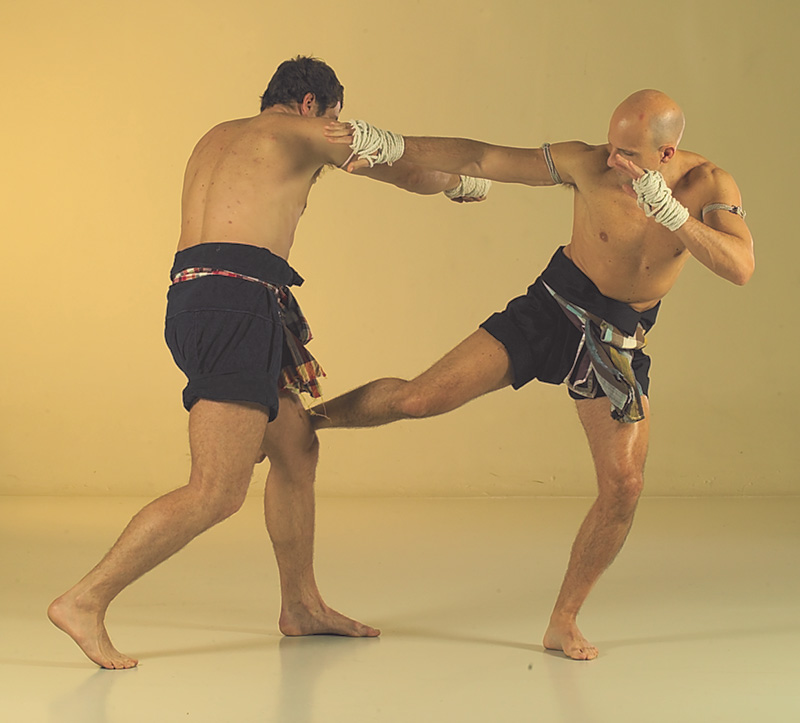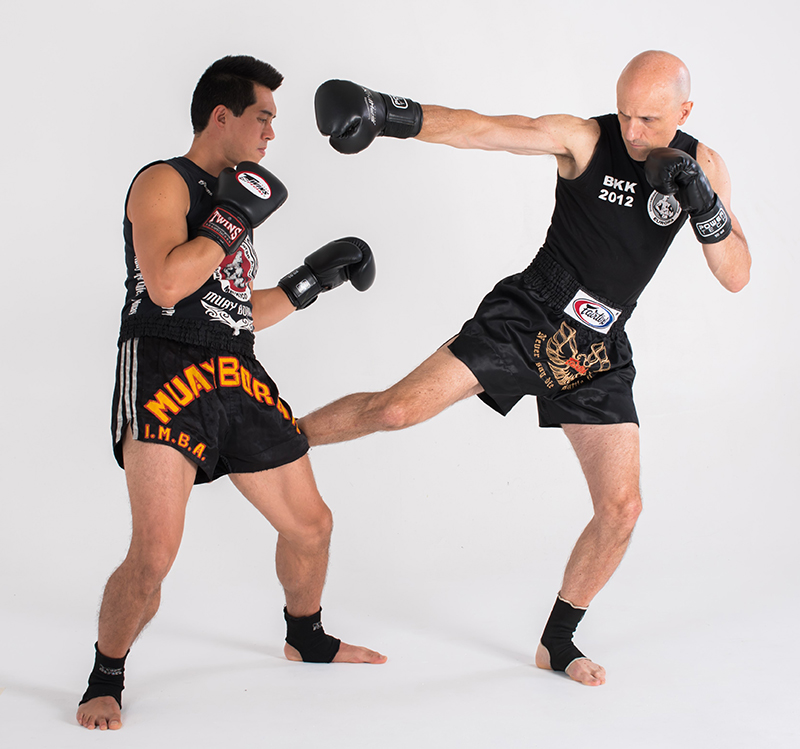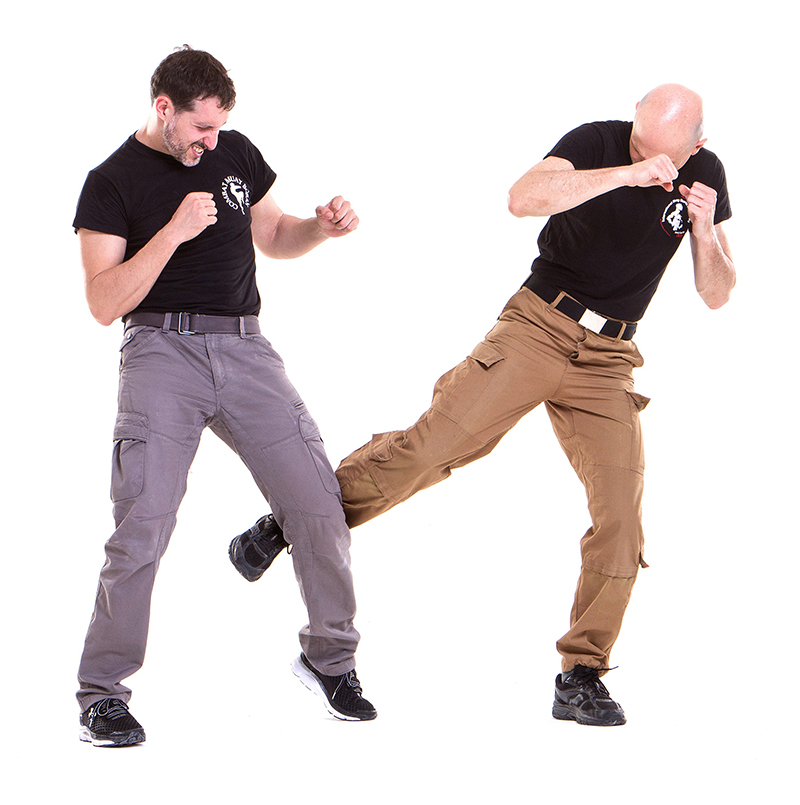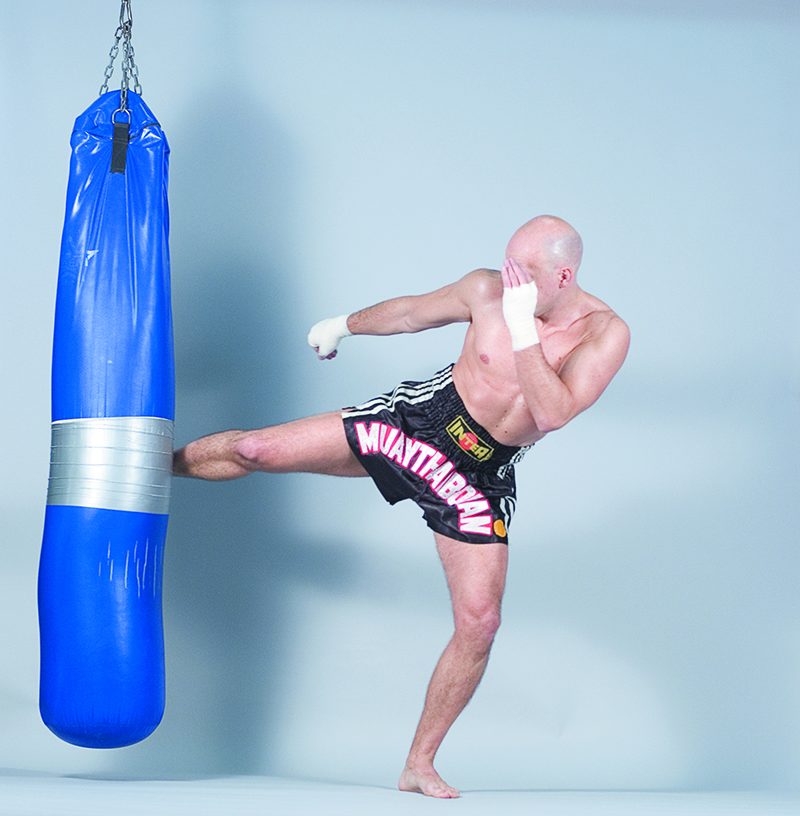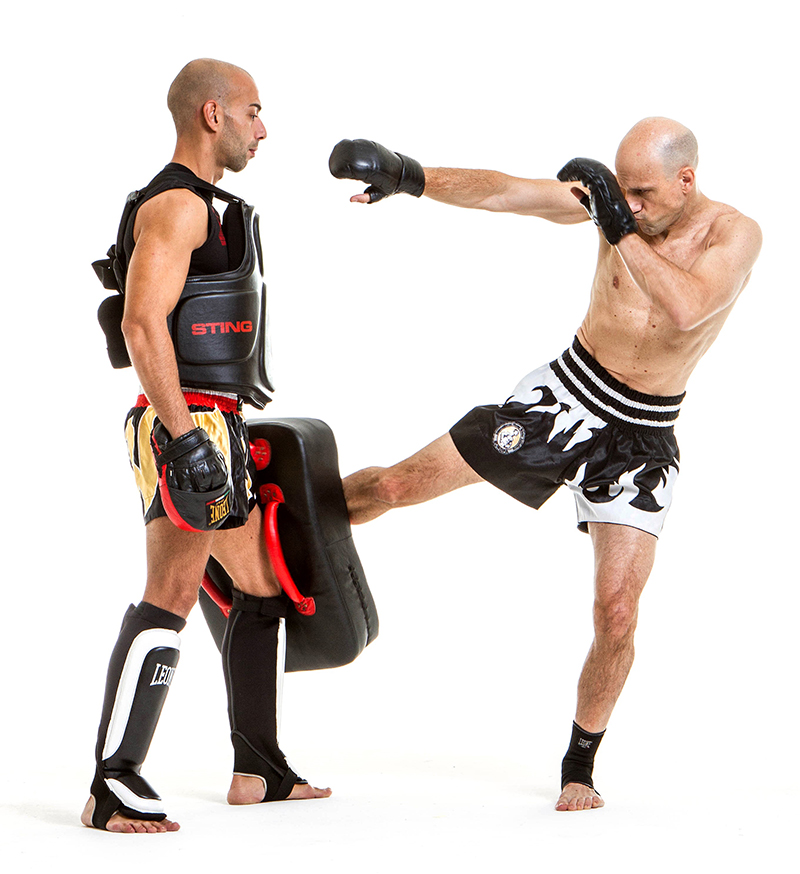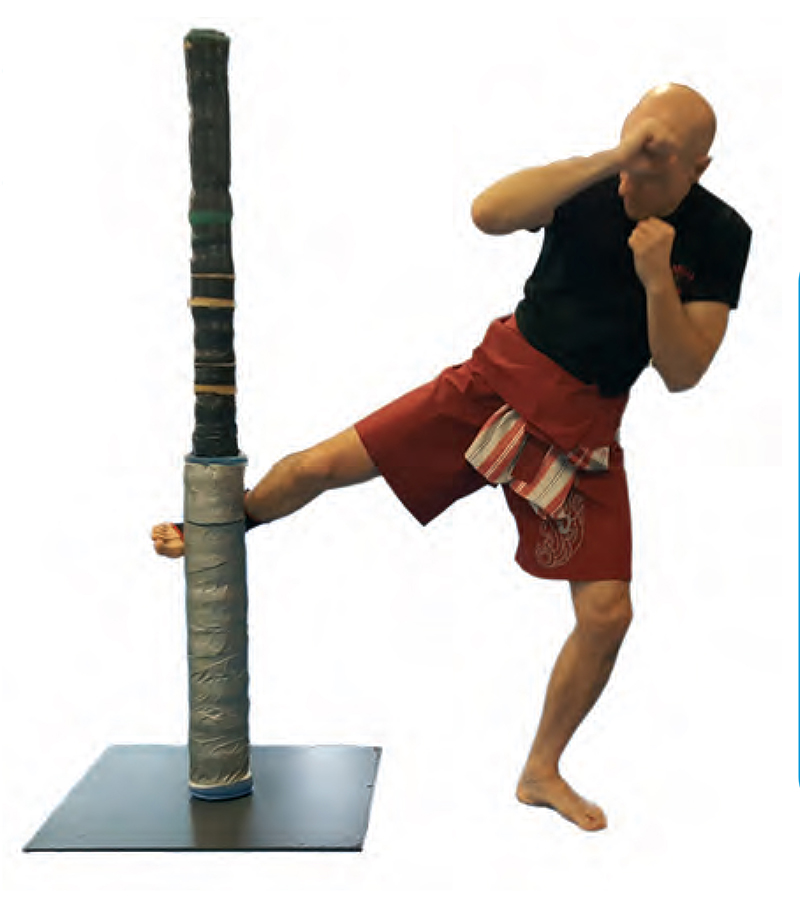
The Muay Thai low kick:
combat sport technique or martial art technique?
By Marco De Cesaris
The Muay Thai roundhouse kicks (Tae Wiang) have always been one of the trademarks of this fighting style. Among the various types of these powerful leg techniques, the Muay Thai low swing kick (Tae Laan) found its place in the world of combat sports for its effectiveness and relative ease of execution. Thai boxers showed the world since the 70’ that roundhouse shin kicks to the legs can become a fighter’s best weapon if properly used. Dozens of Western and Asian fighters fell victim of this deceptive kicks: when the Thai Boxer’s shins started to hit the outer and inner sides of their unaware opponents’ thighs with incredible speed and power, all the fighting strategies crumbled and surrender quickly became the only option. No doubt that a properly executed Muay Thai low swing kick is a fighter’s best friend in the ring but is this technique equally effective in hand-to-hand combat?
-The Muay Lert Rit point of view.
Muay Lert Rit is sometimes called “the dark side of Muay”: the reason for this label is that this Martial Art deals with the technical problems a soldier may face in all-out combat, when, deprived of his weapons, he is forced to annihilate an enemy with his body weapons.
In such a hard situation, a soldier is compelled to employ fighting tactics that can eliminate the enemy in a quick and efficient way. Therefore, strikes are preferred to joint locks and chokes as primary offensive techniques. The targets of the strikes are limited to a few selected ones and the commitment in each attack is total. In such a scenario, is there still a place for swing kicks that are not aimed at an enemy’s groin, when fighting a standing opponent? (it is clear that when the opponent has been taken down the whole situation changes and a lot of targets become available to stomping and swing kicks). In other words, are low kicks useful in all-out combat? Considering that the Look Mai Muay Lert Rit n.30 is about the correct way to throw a low swing kick in hand-to-hand combat, the answer is undoubtedly yes. However, we must distinguish between two very different ways of executing this blow. Let us clarify the why’s and how’s of this statement.
-Two kinds of Low Kicks.
As a matter of fact, if we refer to the standard low kick used in sport fighting we have to deny its effectiveness in hand-to-hand combat. On the other hand, if we refer to the martial version of the same kick, we can say that the Muay low swing kick is a very efficient fighting technique that can cause serious body dis-function with a single strike. Therefore, this kind of specialized kick should be learned and absolutely included in a fighter’s toolbox.
Let’s make this point clear.
The broad family of Muay Thai swing kicks (Tae Wiang) includes several sub-categories of leg attacks. Among the low-line kicks, at least two different kinds of Tae Laan can be employed by an expert Nak Muay. The first type is the well- known combat sport version that all Thai Boxers apply on a regular basis in the ring. This Low Kick has specific features, perfectly adapted to the context: a confrontation between two trained individuals who try to defeat the opposition within the limits of specific rules and regulations.
Let’s analyse the technical features of the combat sport version of a low swing kick.
-Leading body part: the hips. In the correct execution of a combat sport Low Kick, the fighter’s hips must lead the way and turn around the body axis before the kicking leg starts to move. In so doing, the leg is actually loaded with great energy before it starts to be thrown towards the target. As a result, the kicking leg acts like a big whip that hits the target and springs back to its original position. The effect is an explosive strike that is both fast and forceful.
-Position of the kicking leg .The kicking leg is kept relaxed and naturally bent when going towards the target and must be straightened when hitting the opponent’s leg. A rebound effect is thus produced and the kicking leg springs quickly back in its original position.
-Impact zone: middle and low part of the shin bone. This roundhouse kick is typically a long range weapon. In some cases, when employed in combination with specific punches (straights or swings) it can become a middle range weapon. When it is executed at long range, the area of the shin that impacts against the target is the lowest part, closer to the foot. At middle range, the middle part of the shin can be the impact zone, due to the major proximity to the target.
Execution. The combat sport Low Kick’s execution is based on three phases. 1. Turning of the hips 2. Horizontal whip-like slash of the kicking leg 3. Springing back to guard position. The kicking leg must be kept relaxed, throughout.
-Range of execution: long to middle. As mentioned before this kick, while it is obviously usually executed at long range, can also be employed as a middle range offensive technique. By combining the leg attack with “long” punches, even at middle range a good Nak Muay can be very dangerous with his Tae Laan.
-This kick can be compared to: hitting with a baseball bat. When a Thai Boxer correctly executes a Low Kick, the turning of his body can be compared to a baseball player hitting the ball. The kicking leg’s shin is the bat that is swung around to impact against the target (the opponent’s leg). The destructive power of this attack, when properly executed, is awesome.
Now, let’s compare the combat sport version with the martial low swing kick.
-Leading body part: the knee of the kicking leg. In this variation of the Tae Laan, the kicker tends to put as much weight as possible behind the attacking leg. In order to do that, the hips turn but the kicking leg is kept locked in a bent position and doesn’t swing around independently from the pelvis. In other words, the whole body acts as a single unity thus projecting the whole body mass towards the target. The shinbone that impacts against the sensitive areas of the enemy’s thigh, actually bears a big portion of the kicker’s weight behind it.
-Position of the kicking leg: bent when going towards the target and when going back to the ground. Contrary to the combat sport version, in the martial low kick, the attacking leg is not kept relaxed but remains firmly in a bent position when striking and when returning to its original position. The bent leg is connected to the hips and is moved forth and back together with the forward and backward turn of the pelvis area.
-Impact zone: middle and high part of the shin bone. This destructive kick is not conceived to be used in a “sparring” situation when the two contenders move around and constantly change their relative positions. On the contrary, it must always be used at close or (sporadically) middle range, either pre-emptively, when the opponent is unaware of the upcoming attack, or after grabbing, when he is temporarily unable to move away. Therefore, the portion of the shin bone that usually connects with the target is the high or middle zone. The part of the shin closer to the knee is the hardest and therefore the preferred one.
-Execution. The Martial Low Kick’s execution is based on three phases. 1. Turning of the hips 2. Downward cutting at a 45° angle with a bent leg 3. Bringing the kicking leg back to guard position. The leg is kept bent on its way to the target, on impact and when it is going back.
-Range of execution: middle to short. As mentioned before, this technique is meant to be applied in close range combat. Therefore, it must be executed when the kicker is close to the opponent or occasionally at punching (middle) range. A pre-emptive attack is the preferred choice. Otherwise, this kick can be used as a follow up after a grab or a hand attack. In both cases, the executor must ensure that the opponent cannot move out of the way of the low kick because at a longer range this attack loses much of its effectiveness.
-This kick can be compared to: chopping down with an axe. The leg is kept bent and strongly connected to the pelvis and then hacks diagonally down aiming at the opponent’s outer thigh. This kick can be compared to chopping with a lumberjack’s axe. The more explosive the chopping action, the more penetrating the kick and the more damage will be inflicted upon the target. This kind of attack perfectly fits the Muay Lert Rit philosophy of fighting: put them out, fast.
Training systems.
Both kinds of Low Kicks need to be trained on a regular basis in order to become real weapons in a Muay fighter’s arsenal. Impact training is mandatory if a practitioner wants to attain a good level of speed, force and bone conditioning. The three main tools that must be included in every weekly schedule are as follows:
1.Heavy bag.
This tool is ideal for training both kinds of Low Kick. When training the combat sport version, you have to move around the bag and throw combinations from the long to middle range. You can combine punches and low kicks, straight kicks and low kicks, low kicks and knee strikes and so on. For a realistic training of the martial low kick, you have to stand close to the bag, fake a hand strike and unleash a full power diagonal downward cut kick with all your body mass behind the strike.
2.Kicking shield.
This tool is perfect for training the impact of strikes, the combinations and the switch from a given range to another. For example, start at long range throwing straight kicks to the body in combination with (combat sport) low kicks .Then close the gap and follow up with knees, elbows or short punches. The martial low kick can be trained with the kicking shield, too but its use is limited to single power strikes not mixed with other body weapons.
3.Iron post.
The combat sport low kick is better not trained on this hard target. On the contrary, for a real development of a devastating martial low kick this is the best tool. If properly trained with the iron post, the shin will be hardened to an incredible degree and the feeling of penetrating into the target will be highly honed. A warning: careful tuition by an expert Khru Muay Boran is needed not to hurt oneself when hitting the post.
For an in-depth analysis of the possible impact-training routines on the 3 tools above mentioned please refer to the on-line PDF book “Muay Boran IMBA’s training system” available for free download:
https://www.muaythai.it/muay-boran-imbas-training-system-pdf-book/
For more information about Martial Low Kicks:
IMBA Muay Lert Rit textbook


